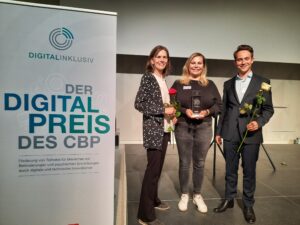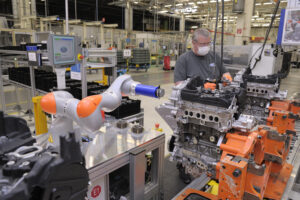Schlagwort: ‘Jahresmagazin Automation’
First movement of PARAGRIP with new control unit
PARAGRIP’s control architecture has been completely redesigned in order to be fully equipped for its future tasks in multidirectional additive manufacturing (MDAM) with arc welding (WAAM). The movements of all four arms can now be planned, simulated and executed on the real robot using MoveIt in ROS2. The joint positions of the physical robot are always fed back to ROS2, allowing the integration of online planning algorithms in the future. The video shows the planning and execution of a simple test motion of the PARAGRIP.
More information about the project can be found here.
Contact: Jan Wiartalla
A multi-layered task sequencing approach
Cobots are highly sought by manufacturing companies in contrast to fully automated production lines, as they provide the additional benefit of flexible operations. A major hurdle with current collaborative setups is tedious setup times for efficient and robust co-working as well as poor support for random interruptions.
This project focuses on enabling autonomous collaborative operations for serial manipulators where interruptions from human agents occur at random while ensuring minimal setup times. To this end, two primary aspects that impact task execution are addressed, namely execution time and co-working as enumerated below:
- A method is developed to minimise the total distance travelled, by following the most optimal sequence for the given task while retaining online operational capabilities
- A real-time replanning and co-working algorithm for randomly interruptive environments is developed and implemented to ensure continued operation even when regions of the workspace are occluded while guaranteeing safety of the human agents in the workspace. The co-working controller operates fully autonomously.
An example of the working of the deployed on a prototype platform consisting of a collaborative UR10e arm, a stereo camera for static environment mapping and a laser scanner for mapping of dynamic obstacles is shown in the video.
Contact: Daniel Gossen
music: madiRFAN – Both of Us (https://pixabay.com/music/beats-madirfan-both-of-us-14037/)
Watch the video on our Youtube channel: here.
Results of the project Next Generation
Der an dieser Stelle eingebundene Inhalt führt Sie auf Seiten, die von der von Google betriebenen Seite YouTube - YouTube, LLC, 901 Cherry Ave., San Bruno, CA 94066, USA - zur Verfügung gestellt werden. Mit dem Aufruf des Inhalts kann YouTube Ihre IP-Adresse und die Sprache des Systems, sowie verschiedene browserspezifische Angaben ermitteln. Wenn Sie in Ihrem YouTube-Account eingeloggt sind, ermöglichen Sie YouTube, Ihr Surfverhalten direkt Ihrem persönlichen Profil zuzuordnen. Dies können Sie verhindern, indem Sie sich aus Ihrem YouTube-Account ausloggen. YouTube verwendet Cookies und Tracking-Tools. Die Datenverarbeitungsvorgänge sowie die Zwecke der Verarbeitung können direkt bei YouTube erfragt und eingesehen werden.
At the end of the Next Generation project, the perspectives of all those involved were collected. As always, the focus is on people. With the inclusive workplace and the collaborative robot, the project shows new perspectives for the employment of people with multiple disabilities. HRC is an enabler for inclusion in the primary labor market! We are happy about the great project results and the video reflecting them.
For more information about the project, click here.
Contacts:
Carlo Weidemann
Elodie Hüsing
Mathias Hüsing
Next Generation project wins 3rd Digital Prize

Together with our project partners Caritas Wertarbeit Köln e.V. and the Fachhochschule des Mittelstands (University of Applied Sciences for Small and Medium Enterprises), we accepted the third place in the Digital Prize and the prize money of 2,000 euros for the Next Generation project at the Futurium in Berlin on Tuesday, 3 May.
The Digital Prize is being awarded for the second time since 2019. According to the theme ‘Digital Inclusive’, the CBP aims to promote the use of digital technologies for people with disabilities and mental illnesses in the fields of disability assistance, psychiatry, politics, research, and business. At the end of the project, we are delighted to have received this award and would like to thank all those involved in and supporting the project. Next Generation is funded by the Stiftung Wohlfahrtspflege NRW, the Landschaftsverband Rheinland and the Caritasverband der Stadt Köln e.V.
Der an dieser Stelle eingebundene Inhalt führt Sie auf Seiten, die von der von Google betriebenen Seite YouTube - YouTube, LLC, 901 Cherry Ave., San Bruno, CA 94066, USA - zur Verfügung gestellt werden. Mit dem Aufruf des Inhalts kann YouTube Ihre IP-Adresse und die Sprache des Systems, sowie verschiedene browserspezifische Angaben ermitteln. Wenn Sie in Ihrem YouTube-Account eingeloggt sind, ermöglichen Sie YouTube, Ihr Surfverhalten direkt Ihrem persönlichen Profil zuzuordnen. Dies können Sie verhindern, indem Sie sich aus Ihrem YouTube-Account ausloggen. YouTube verwendet Cookies und Tracking-Tools. Die Datenverarbeitungsvorgänge sowie die Zwecke der Verarbeitung können direkt bei YouTube erfragt und eingesehen werden.
Contacts:
Mathias Hüsing
Carlo Weidemann
Elodie Hüsing
Transformation of workplaces by human-robot collaboration (HRC) at Ford
Since April 2021, employees with disabilities have been working successfully with a collaborative robot at the production line of Ford engine plant in cologne. The robot takes over the unergonomic pressing of the VCT solenoids into the engine cover and the employee installs the screws. During this process, humans and robots work simultaneously in the same workspace. The key findings and results of the project are summarized in the strategy paper.
Further information on the project can be found here.
Contact:




